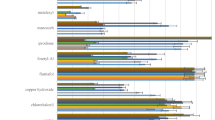Abstract
Two bacterial isolates and one strain of Trichoderma harzianum were tested alone and in combination with chitin for efficacy in control of root rot disease caused by Phytophthora capsici and Rhizoctonia solani in pepper plants under greenhouse conditions. These bacteria (Bacillus subtilis HS93 and B. licheniformis LS674) were isolated from repeatedly washed roots of pepper plants. In in vitro assays, HS93, LS674 and T. harzianum were antagonistic against P. capsici and R. solani and produced high levels of chitinase. Seed treatment and root drenching with bacterial suspensions of HS93 with 0.5% chitin was more effective against Phytophthora and Rhizoctonia root rot than addition of the organisms without chitin. LS674 and T. harzianum reduced Rhizoctonia but not Phytophthora root rot. In two greenhouse tests, seed treatment and root drenching with HS93 amended with chitin enhanced its biocontrol activity against P. capsici but not on R. solani. The effects of LS674 and T. harzianum against R. solani were significantly enhanced when they were used as suspensions with 0.5% chitin for root drenching, but this had no effect on P. capsici. In both greenhouse experiments, the use of 0.5% chitin alone for root drenching reduced Rhizoctonia root rot. Reduction of root rot disease was accompanied by increased yield. These results show that the antagonistic activity of HS93, LS674 and T. harzianum may be stimulated by chitin resulting in significant improvements in their effectiveness against pathogens.
Similar content being viewed by others
References
De Boer W, Gerards S, Klein Gunnewiek PJA and Modderman R (1999) Response of the chitinolytic microbial community to chitin amendments of dune soils. Biology and Fertility of Soils 29: 170-177
Manjula K and Podile AR (2001) Chitin-supplemented formulations improve biocontrol and plant growth promoting efficiency of Bacillus subtilis AF 1. Canadian Journal of Microbiology 47: 618-625
Raupach GS and Kloepper JW (1998) Mixture of plant growthpromoting rhizobacteria enhance biological control of multiple cucumber pathogens. Phytopathology 88: 1158-1164
Roberts WK and Selitrennikoff CP (1988) Plant and bacterial chitinases differ in antifugal activity. Journal of General Microbiology 134: 169-176
Roby D, Gadelle A and Toppan A (1987) Chitin oligosaccharides as elicitors of chitinase activity in melon plants. Biochemistry and Biophysics Research Communication 143: 885-892
Sid Ahmed A, Pérez C and Candela ME (2000) Evaluation of induction of systemic resistance in pepper plants (Capsicum annuum) to Phytophthora capsici using Trichoderma harzianum and its relation with capsidiol accumulation. European Journal of Plant Pathology 106: 817-824
Sid Ahmed A, Pérez C, Egea C and Candela ME (1999) Evaluation of the capacity of Trichoderma harzianum in controlling rot caused by Phytophthora capsici in pepper plants. Plant Pathology 48: 58-65
Sneath PHA (1986) Endospore forming gram-positive rods and cocci. In: Sneath PHA, Mair NS, Sharpe ME and Holt JG (eds) Bergey's Manual of Systematic bacteriology, Vol 2 (pp 1104-1137) William and Wilken, Baltimore, MD
Yedidia I, Benhamou N and Chet I (1999) Induction of defense responses in cucumber plants (Cucumis sativus L.) by the biocontrol agent Trichoderma harzianum. Applied and Environmental Microbiology 65: 1061-1070
Zhang Z and Yuen Y (2000) The role of chitinase production by Stenotrophomonas maltophilia strain C3 in biological control of Bipolaris sorokiniana. Phytopathology 90: 384-389
Zhang Z, Yuen Y, Sarath G and Penheither AR (2000) Chitinases from the plant disease biocontrol agent, Stenotrophomonas maltophilia C3. Phytopathology 91: 204-211
Author information
Authors and Affiliations
Corresponding author
Rights and permissions
About this article
Cite this article
Sid Ahmed, A., Ezziyyani, M., Pérez Sánchez, C. et al. Effect of chitin on biological control activity of Bacillus spp. and Trichoderma harzianum against root rot disease in pepper (Capsicum annuum) plants. European Journal of Plant Pathology 109, 633–637 (2003). https://doi.org/10.1023/A:1024734216814
Issue Date:
DOI: https://doi.org/10.1023/A:1024734216814




